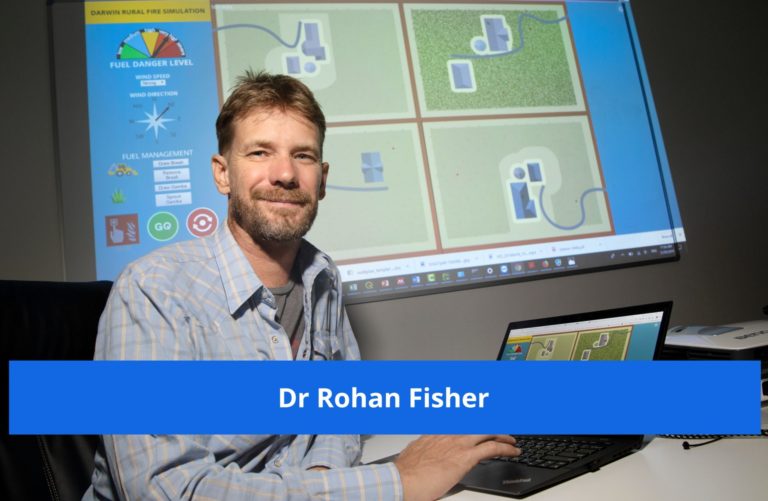Schools throughout the Northern Territory – and across Australia – now have access to a new simulation game that teaches players about fire behaviours and risks, and how to help protect Australian wildlife.
The simulation includes three games that show how weather, wind, and the ways different types of grasses burn affect the nature of a fire. Specifically, how sprout spinifex, Buffel grass and other invasive species are particularly fire hazardous.
The game asks players to protect buildings, waterholes, and Tjakura [a desert skink] burrows.
Desert Block Fire Simulation was developed as a collaboration between the Indigenous Desert Alliance and Charles Darwin University’s (CDU) Northern Institute.
CDU Northern Institute researcher Dr Rohan Fisher and his team developed a similar game in 2018. Since then, he says, people have been much more engaged with their work.
“They [Bushfires NT authority] used to just sit around with just a bunch of pamphlets at a table and were largely ignored [at conventions],” he told EducationDaily. “Now they’ve got this four-dimensional interactive simulation for people to interact with. Now people come to talk and learn about fire management issues.”

Educating students about fire danger saves lives
Dr Fisher believes Desert Block Fire Simulation will have similar success in spreading fire danger awareness in the regions around Australia.
“It’s a bit of a game-changer in how we think about land and fire management as a complex, nuanced, sophisticated science and technology, local indigenous knowledge issue,” Dr Fisher told EducationDaily.
“It’s different from what traditional emergency response and bushfire agencies have been doing. I can see a lot of opportunities for this to be scaled out in that space.”
Reducing fire risk is a national issue
Dr Fisher says he believes the simulation will also be valuable to teachers outside of the Northern Territory.
“Because it’s online and open source and accessible by anyone, I think it can be used more broadly,” he says. “I think the next step for us is to start stretching it into a bit of curriculum and wrapping more concepts so teachers can grab it and create some lessons around it. The next step is to continue to increase the land management range and turn this into a more broad land management fire simulation game.”
Educators today, he says, hear so much about what kids need to be learning – “and so much of it is in the tech space around AI and robots”.
“One thing we’re going to need in the future is an increasing understanding of the Australian environment ,which includes land and fire management,” Dr Fisher says.
Technology is a vital educational tool
Dr Fisher says use of simulation and games can be helpful for education.
“By getting them to play and get involved they can teach themselves, essentially,” he told EducationDaily.
“You can tell people something and they may or may not understand, but if they can teach themselves that’s when it sticks.”
For younger generations who face a future affected by climate change, the likelihood of seeing more fires in regional and rural Australia is increasing. Dr Fisher says the time for educating them about land and fire management is now.
When it comes to building disaster risk resilience in what is going to be a more disaster prone future, Dr Fisher says, “ultimately, the responsibility for that mitigation comes down to individuals, and we need to think of new ways of getting people to think for themselves and understand the complexity of disasters and disastrous mitigation”.
“Whether it be floods, fires or whatever, I think about newer or engaging de-centralised ways of getting that information out to young people.”









